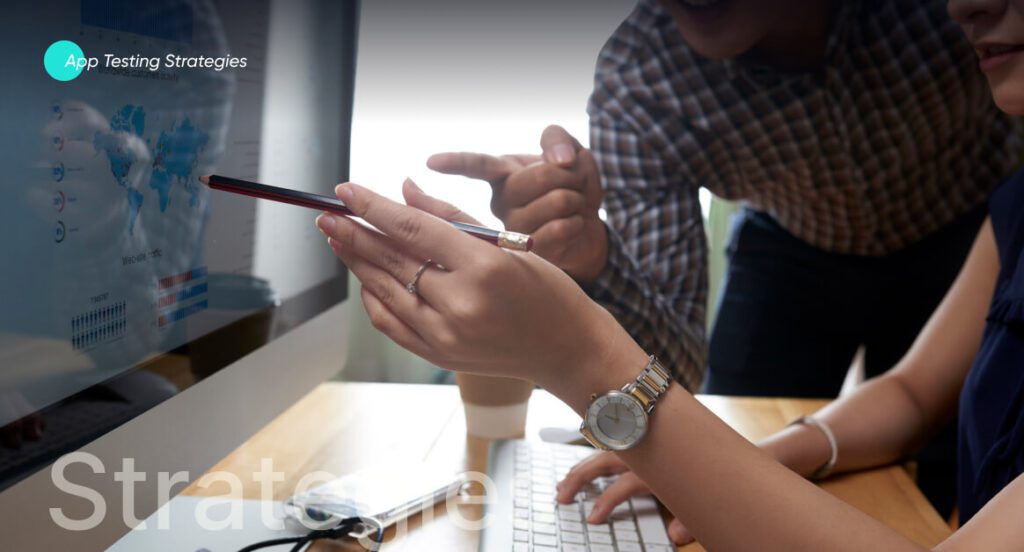Essential App Testing Strategy: For Mobile App Development
Quality control is a critical element of the software development process, and it ensures that the software is high-quality, reliable, and meets customers’ requirements. To reinforce quality control, QA engineers execute the app testing strategy for every app in the development process. It is a thorough plan that specifies how an application will be tested to validate that it meets the proposed requirements, functions smoothly, and is bereft of defects or errors.
This strategy typically includes a set of testing explanations, test cases, testing environments, and testing methodologies used to evaluate the application’s quality, performance, and usability. It is no surprise why IT businesses allocate a huge chunk of their budget to quality control. The article highlights top app testing strategies you can incorporate into your quality control methodology.
Partner with us to create a scalable, reliable, and error-free app. Contact us. ![]()
Why do Mobile Apps Require Testing Strategies?

Research indicates that Apple and Google control over 95 percent of the app store market share. Apple’s app store currently has 1.76 million apps, while Google Play boasts 2.26 million apps. The app industry on iOS and Android is presently worth around $6.3 trillion.
So the number of smartphone users is witnessing a dramatic rise, and so is the number of app downloads. However, the cutthroat competition makes it extremely difficult for a business to keep afloat. If truth be told, over 80% of mobile apps are deleted after their first use. Most of these apps offered poor user experience with pressing issues such as slow app performance, bugs and glitches, and long loading times.
Therefore, software businesses must implement effective and rigorous app testing strategies to combat bugs, glitches, and other errors. By implementing such procedures, companies can avoid the pernicious effects of users’ negative app reviews and ratings, resulting in business losses.
Main pillars of mobile app testing strategies
The mobile app testing strategy has five main pillars: responsiveness, stability, scalability, resource usage, and compatibility. Every pillar is indispensable to ensuring an app’s optimum performance and user experience.
Top Seven App Testing Strategies

1. Integration testing
Integration testing the process of testing the interactions and interfaces between different components or modules. It is crucial because it helps to ensure that an application works correctly on different platforms. It can also help identify and resolve any issues or defects early in the development process, saving time and money in the long run.
In application testing, integration testing involves testing an application’s ability to integrate and communicate with other applications, databases, or systems it depends on. By testing the integration of other parts of an application, developers can ensure that the application works as expected and meets the desired performance and functionality requirements.
Different types of integration testing exist, such as top-down integration, bottom-up integration, and extensive bang integration. In top-down integration, the testing starts at the top-most level and detects issues in the app architecture. The bottom-up integration begins at a lower level and identifies problems with single modules or elements. The big bang includes testing an app’s entire modules and components at once.
2. Cross-platform testing
The cross-platform strategy involves testing an app on several mobile operating systems to ensure it works smoothly on all platforms and meets user expectations. This strategy comprises various methods that you can use for testing.
You can start by determining which platforms to include in the testing. Then you can use emulators to test your app on virtual devices, which saves you time and money. However, if real devices are more suitable for testing, you can use cloud-based testing to access many real devices. You can also use automated testing by employing tools like Appium, Calabash, or Xamarin – as they can increase speed and ensure reliability.
Additionally, you can test your app for platform-specific features, as different platforms have unique characteristics and perimeters. You can test compatibility and detect if your app is compatible with various devices and screen sizes. You can also push for performance, as some apps might have performance issues due to hardware and software differences. Finally, you can test beta to identify the overlooked problems during development and testing.
3. Visual regression testing
Visual regression testing is a strategy with an explicit focus on the comparison of visual components of an app to ensure there are no inaccuracies in the visual elements. This strategy detects any differences in visual appearance that could be introduced by code changes or new features, which could adversely impact the user experience.
The following methods are the critical steps involved in visual regression testing. You can begin by creating a baseline screenshot of your app’s initial visual appearance as a reference for future testing. You can also perform changes to the app that can affect its visual appearance. Take a new screenshot of the app’s current visual appearance after making the changes, compare the two screenshots, and detect any changes in the visual appearance. If you discover any changes, then you can rectify the issue.
Visual regression testing can help you detect visual issues, save time and resources, enhance your app’s quality across several platforms, and improve the overall user experience.
4. Feature functionality testing
Feature functionality testing involves testing an app’s numerous features and functions to ensure that they are working smoothly. Paying attention to the features can determine if bugs, errors, or inconsistencies hamper an app’s functionality.
The following are critical steps to follow when performing feature functionality testing. You can start by determining the app’s feature and creating test cases for each feature, highlighting the steps a user typically takes to run the feature. Then you can continue testing the features using the test cases and identify bugs, errors, and inaccuracies. If you come across any issues, then report them to the development team. After the issues have been fixed, you can retest the features to ensure that the features are devoid of bugs and errors.
Feature app testing provides various benefits, such as ensuring app quality which can improve user experience. Similarly, the test can determine the app’s reliability and identify bugs at an early stage.
5. Front-end testing
Front-end testing is a type of app testing strategy that focuses on testing an app’s user interface (UI) and user experience (UX). The testing ensures that the app’s front-end components, such as buttons, forms, and menus, are working correctly and providing a positive user experience.
The following are the vital steps for performing the front-end testing. You can start by identifying the app’s front-end components and create test cases for each front-end component by highlighting how the user will interact with them. Then you can use the test cases on the app’s front-end components to identify any issues. If any issues are found, you can report them to the development team and retest the front-end components after fixing them.
Front-end testing strategy offers vital benefits such as ensuring a better user experience, identifying UI/UX issues early, boosting app quality, and improving app usability.
6. Back-end testing
Back-end testing entails testing the server-side components of an app, such as the database, APIs, and server logic, to ensure that app’s back-end components are working smoothly and handling data appropriately.
The following vital methods are crucial when performing back-end testing. You can begin by determining an app’s back-end components, building test cases, performing testing, reporting issues to the development team, and retesting the back-end components for any errors. The benefits of back-end testing include ensuring data integrity, bolstering app security, and boosting app performance and reliability.
7. Security testing
Security testing is an app testing strategy that focuses on identifying security issues. Security testing ensures the app is secure and protected against unauthorized access, data theft, and other security threats. If you release an app that is not entirely secure and reliable, the risk of data leaks exists, which can cause businesses vast amounts of money. Therefore, it is essential to perform security testing.
While performing security testing, you should determine potential vulnerabilities in the app, such as weaker authentication or unencrypted communication. You can build test cases, perform testing, report issues to the development team, and retest the app after fixing the problems. Security testing is crucial because it beefs up an app’s security and reliability, protects user data, and enhances app compliance with security regulations and standards such as PCI, DSS, HIPAA, and GDPR.
See our latest relevant exploration Benefits of App Redesign ![]()
FAQs
How can I improve my mobile app testing?
You can improve mobile app testing capabilities by using automation, conducting tests on actual devices, getting feedback from real users, performing expiatory testing, use monitoring and analytical tools. These methods can continuously improve your testing process to increase the efficiency of your testing efforts.
Which is the best app testing strategy?
It is impossible to pick one app testing strategy that suits all applications or projects. The most productive and suitable strategy will depend on specific requirements and factors such as the type of application, the intended user audience, the level of complexity, and the available resources.
How much time is required to conduct mobile app testing?
The amount of time required to conduct mobile testing depends on the mobile application’s complexity, the testing’s scope, and the resources available for testing. A simple mobile app with basic functionality may require only a few hours of testing. In contrast, a complex app with multiple features, integrations, and compatibility requirements may require several days or weeks of testing.
Gohar is a seasoned IT writer specializing in leading technologies. He holds a Diploma and Bachelor's degree from the University of London, with professional experience spanning over five years in the IT sector. His expertise involves a keen focus on mobile applications, web apps, blockchain, content management systems, e-commerce, and fintech. Beyond the professional field, Gohar is an avid reader and reads extensively about emerging and innovative technologies.